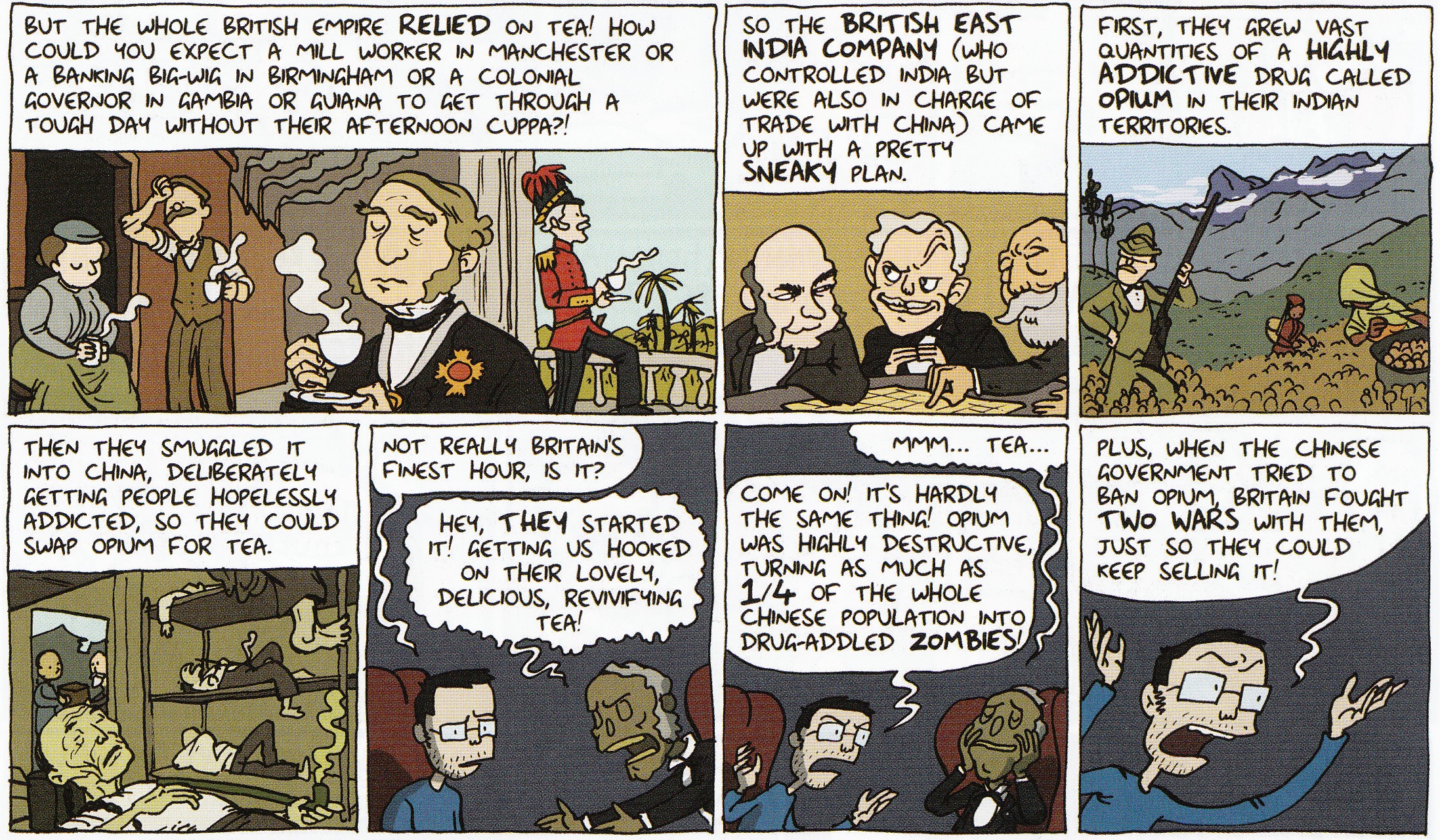 Running in British weekly comics magazine The Phoenix, now seeing its second collected volume released by David Fickling Books, the conceit of Corpse Talk is that the reader is viewing a talk show. The host—the cartoonist—is visited by the dead bodies of big movers of the past, now deceased, and together they discuss important moments in their recorded life (or debunk common misreadings of history, with much indignance on the part of the guest). It’s one of my favourite comics going; it’s a comic that’s for kids, and it treats them like an audience worth having.
Running in British weekly comics magazine The Phoenix, now seeing its second collected volume released by David Fickling Books, the conceit of Corpse Talk is that the reader is viewing a talk show. The host—the cartoonist—is visited by the dead bodies of big movers of the past, now deceased, and together they discuss important moments in their recorded life (or debunk common misreadings of history, with much indignance on the part of the guest). It’s one of my favourite comics going; it’s a comic that’s for kids, and it treats them like an audience worth having.
Depicting history as a visitable place full of interesting, relatable petty individuals instead of a tiresome reduction (“like nowadays, but they were worse and had less, and so were less, less human”) is something that a good historian can do. Lucy Worsley, Neil Oliver, Mary Beard, Janina Ramirez—adults hungry for accessible edutainment are well catered for in the UK scene by these creators. For children, the wider landscape is OK; there have been Tony Robinsons, Terry Dearys, and Martin Browns. But more is always better, where quality’s concerned. More means “more choice.” Hey kids! Choose comics!
Though I appreciate many aspects of this book, I want to start with the colouring. Colouring is perhaps the easiest part of comic art to forget to notice (Or maybe lettering? It’s probably a draw), especially in a situation where one person does everything else. The book cover and the website credits Adam Murphy. Lisa Murphy is credited on the first page, but it’s a shame her name isn’t afforded any more lights, because her work in this book is excellent and that begins before her name. It begins on the cover of the book, where the floodlit, nighttime panorama of the Houses of Parliament under the fireworks behind the title provides the highlight that makes the cover work. Murphy is interviewing a corpse in a hat—who could he be? Without the cue to notice the background, the relevant environment, the viewer’s left in the dark. Oh, he’s in front of that building; he must be Guy Fawkes. Of course! The building is further emphasised by the reddish tint to the sky immediately above it, which fades into a much darker hue above (all the better to show off the Bonfire Night fireworks). It’s Adam’s idea, Adam’s scaffold, but Lisa’s rimshot.
Similarly, in the rare double-page spreads, her choices allow complex scenes to shine. A Fire of London scene (viewable here) full of people and hijinks is easy to read, as is the water of the Thames turned orange in reflection. In the Sad Ending, Continued spread following Pocahontas’ appearance, Murphy and Murphy combine forces to create a forest scene that is beautiful to look at and all the sadder for it—depth, composition and golden hour lighting through a leafy canopy emphasise the forest as a place that was a home environment, a familiar place that people knew. The obvious beauty of what’s being stolen juxtaposed with colonial violence (and the English forces effectively walking “away” from, ignoring, the scenery) is a lesson in itself.
The Pocahontas episode is probably one of the best of this second volume, simply because it pulls on its wellies and wades right out into the Disney stream. The movies made you think it was really like this, but the movies were wrong and it wasn’t. But Corpse Talk doesn’t berate the child reading for having believed what they were told by culture and adult authority. Pocahontas cheerfully negs John Smith—and via him, the colonial establishment—for telling fibs about what really happened and how successful he really personally was. Corpse Talk often gently suggests to its audience that what they’ve been told elsewhere or before isn’t necessarily the bone-deep truth, that even if you could ask a figure from it face to face “what really happened?” History isn’t necessarily a rigid wrong-or-right canon, and that people telling them things might not have all of the facts in their hand. History that doesn’t only offer education about the people who came before, but that also encourages children towards the questioning state of mind that will allow them to become historians if they so desire, makes Corpse Talk a fantastic book.
It’s also very funny. Enjoy these excerpts from the strip, and get hyped to own a book full of two-page potted past.





